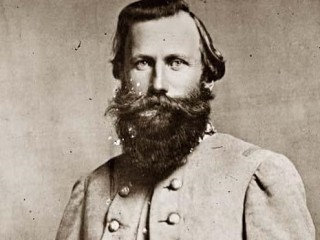
J.E.B. Stuart biography
Date of birth : 1833-02-06
Date of death : 1864-05-11
Birthplace : Patrick County, Virginia, U.S.
Nationality : American
Category : Historian personalities
Last modified : 2011-07-15
Credited as : Army officer, American Civil War,
J.E.B. Stuart was born in Patrick County, Va., on Feb. 6, 1833. Educated at home and at Emory and Henry College, he entered the U.S. Military Academy in 1850 and graduated thirteenth in the class of 1854. On Nov. 14, 1855, he married Flora Cooke; they had three children.
Commissioned brevet second lieutenant in the Mounted Rifles, Stuart was transferred to the 1st U.S. Cavalry in 1855. In October 1859 he served as aide to Col. Robert E. Lee in capturing John Brown at Harpers Ferry, Va. He resigned his commission when Virginia seceded from the Union, and as the Civil War began he accepted appointment as colonel of the 1st Virginia Cavalry.
Assigned to Gen. Joseph E. Johnston in the Shenandoah Valley, Stuart quickly distinguished himself for daring. Gallantry at First Manassas (Bull Run) in July 1861 earned him a brigadier general's wreath. In June 1862 Gen. Lee ordered him to reconnoiter Gen. George B. McClellan's rear positions on the Virginia Peninsula. Leading 1,200 men, Stuart won lasting renown with his "Ride around McClellan." Promoted to major general in July 1862, he took command of the cavalry division of Lee's Army of Northern Virginia.
Stuart became one of the most skilled scouts and intelligence officers in the war. He distinguished himself in the campaign of Second Manassas, and in the invasion of Maryland he and his dismounted troopers proved stubborn fighters. In December 1862 Stuart's horse artillery helped stall the attack on Stonewall Jackson's corps at Fredericksburg. Perhaps his most decisive action came during Jackson's march to intercept Gen. Joseph Hooker in the Virginia Wilderness in April 1863. Assigned the task of discovering enemy plans and screening the Confederate advance, Stuart, plumed hat everywhere in evidence, his banjo-playing companion, "Sweeny," in tow, did superbly. When Jackson was mortally wounded in the Battle of Chancellorsville on May 2, Stuart took temporary command of the II Corps and handled it well in the action of May 3.
At Brandy Station, Va., Stuart's cavalry was surprised and sorely tested for the first time. In the Gettysburg campaign, Stuart's love of adventure led him to his one glaring blunder; when Lee most needed him, Stuart was away on a raid toward Washington, D.C. Rejoining the army on July 2, Stuart's command had no decisive part in the Battle of Gettysburg.
Stuart did not disappoint Lee again. With dwindling manpower and scant forage, he managed Lee's cavalry adroitly through the winter and spring of 1863-1864. On May 11, 1864, Stuart halted Gen. Philip Sheridan's big corps heading for Richmond, but he was wounded at Yellow Tavern and died the next day. His death removed a quality of zeal from Lee's cavalry and left a permanent gap in Southern leadership.
















